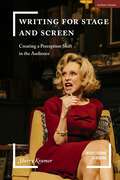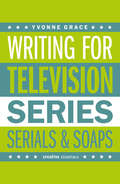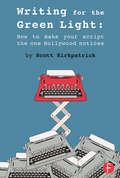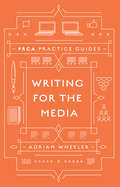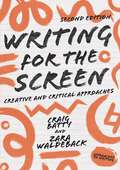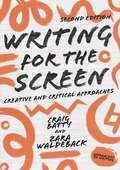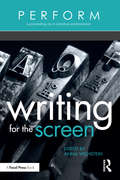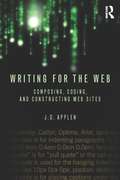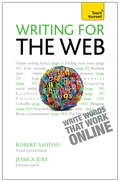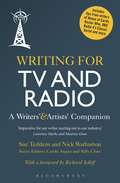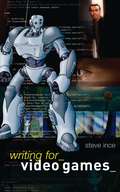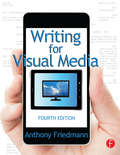- Table View
- List View
Writing for Social Scientists, Third Edition: How to Start and Finish Your Thesis, Book, or Article (Chicago Guides to Writing, Editing, and Publishing)
by Howard S. BeckerFor more than thirty years, Writing for Social Scientists has been a lifeboat for writers in all fields, from beginning students to published authors. It starts with a powerful reassurance: Academic writing is stressful, and even accomplished scholars like sociologist Howard S. Becker struggle with it. And it provides a clear solution: In order to learn how to write, take a deep breath and then begin writing. Revise. Repeat. This is not a book about sociological writing. Instead, Becker applies his sociologist’s eye to some of the common problems all academic writers face, including trying to get it right the first time, failing, and therefore not writing at all; getting caught up in the trappings of “proper” academic writing; writing to impress rather than communicate with readers; and struggling with the when and how of citations. He then offers concrete advice, based on his own experiences and those of his students and colleagues, for overcoming these obstacles and gaining confidence as a writer. While the underlying challenges of writing have remained the same since the book first appeared, the context in which academic writers work has changed dramatically, thanks to rapid changes in technology and ever greater institutional pressures. This new edition has been updated throughout to reflect these changes, offering a new generation of scholars and students encouragement to write about society or any other scholarly topic clearly and persuasively. As Becker writes in the new preface, “Nothing prepared me for the steady stream of mail from readers who found the book helpful. Not just helpful. Several told me the book had saved their lives; less a testimony to the book as therapy than a reflection of the seriousness of the trouble writing failure could get people into.” As academics are being called on to write more often, in more formats, the experienced, rational advice in Writing for Social Scientists will be an important resource for any writer’s shelf.
Writing for Stage and Screen: Creating a Perception Shift in the Audience (Introductions to Theatre)
by Sherry Kramer"This book does what no other playwriting book in my experience has done, it offers a new way of seeing and conceiving how theatre makes meaning and carries emotional impact in performance."Suzan Zeder, Professor Emerita and former Head Of Playwriting at University of Texas at Austin, USACombining a step-by-step analysis of the technique of writing for stage and screen with how the mystery, poetry, and emotional momentum is achieved for the audience, Sherry Kramer offers an empowering, original guide for emerging and established writers. In this structured look at the way audience members progress through a work in real time, Sherry Kramer uses plain-spoken vocabulary to help you discover how to make work that will mean more to your audiences. By using examples drawn from plays, film, and streaming series, ranging from A Streetcar Named Desire to Fleabag to Pirates of the Caribbean, this study makes its concepts accessible to a wide range of artists who work in timebound art. The book also features multiple exercises, developed with MFA writers in The Iowa Playwrights Workshop and The Michener Center for Writers, where Kramer taught for the past 25 years, which provide entrance points to help you consider and create your work.
Writing for Television: A Complete Writer's Guide to Series, Serials and Soaps
by Yvonne GraceA no-nonsense, direct down-the-lens look at the television industry written from the point of view of a television drama producer who's been there, done it, fought some battles and won the odd award. Written in an engaging, anecdotal tone, Writing for Television provides advice on:Getting an agentThe type of writer television's looking forThe tool kit a television writer needsThe writer/script editor relationshipHow to structure a storylineHow to write good treatments and outlinesPacked full of useful insights, links and information, the book includes interviews with successful television writers working today, pointers on how to work collaboratively in the industry and how to make good contacts with the people who can further your career.'Yvonne delivers a practical, accessible, no-nonsense guide to the world of writing for popular TV' - Mal Young, Producer, writer and former BBC Controller of Drama Series'A very comprehensive and informative book on TV script writing. Yvonne covers every conceivable point that will help writers wanting to break into writing for the small screen, whilst at the same time creating a very accessible read' - Tony McHale, Sanctuary Films
Writing for the Green Light: How to Make Your Script the One Hollywood Notices
by Scott KirkpatrickTailor your screenplay to sell. Find out what Hollywood script readers, producers, and studio executives want in a screenplay (and why) from someone who’s been there. Discover what it takes to begin a lasting career as a screenwriter. Peppered with interviews from established professionals, Writing for the Green Light: How to Make Your Script the One Hollywood Notices gives you a sharp competitive edge by showcasing dozens of everyday events that go on at the studios but are rarely if ever discussed in most screenwriting books. With his behind-the-scenes perspective, Scott Kirkpatrick shows you why the system works the way it does and how you can use its unwritten rules to your advantage. He answers such questions as: Who actually reads your script? How do you pique the interest of studios and decision makers? What do agents, producers, and production companies need in a script? How much is a script worth? What are the best genres for new writers and why? What are real steps you can take to ‘break in’ to television writing? How do you best present or pitch a project without looking desparate? How do you negotiate a contract without an agent? How do you exude confidence and seal your first deal? These and other insights are sure to give you and your screenplay a leg-up for success in this competitive landscape!
Writing for the Green Light: How to Make Your Script the One Hollywood Notices
by Scott KirkpatrickTailor your screenplay to sell. Find out what Hollywood script readers, producers, and studio executives want in a screenplay (and why) from someone who’s been there. Discover what it takes to begin a lasting career as a screenwriter. Peppered with interviews from established professionals, Writing for the Green Light: How to Make Your Script the One Hollywood Notices gives you a sharp competitive edge by showcasing dozens of everyday events that go on at the studios but are rarely if ever discussed in most screenwriting books. With his behind-the-scenes perspective, Scott Kirkpatrick shows you why the system works the way it does and how you can use its unwritten rules to your advantage. He answers such questions as: Who actually reads your script? How do you pique the interest of studios and decision makers? What do agents, producers, and production companies need in a script? How much is a script worth? What are the best genres for new writers and why? What are real steps you can take to ‘break in’ to television writing? How do you best present or pitch a project without looking desparate? How do you negotiate a contract without an agent? How do you exude confidence and seal your first deal? These and other insights are sure to give you and your screenplay a leg-up for success in this competitive landscape!
Writing for the Masses: Dorothy L. Sayers and the Victorian Literary Tradition (Routledge Studies in Twentieth-Century Literature)
by Christine ColónIn Writing for the Masses: Dorothy L. Sayers and the Victorian Literary Tradition Dr. Christine A. Colón explores how Sayers carefully negotiates the complexities of early twentieth century literary culture by embracing a specifically Victorian literary tradition of writing to engage a wide audience. Using a variety of examples from Sayers’s detective fiction, essays, and religious drama, Dr. Colón charts Sayers’s development as a writer whose intense desire to connect with her audience eventually compels her to embrace the role of a Victorian sage for her own age. Ultimately, the Victorian literary tradition not only provides her with an empowering model for her own work as she struggles as a writer of detective fiction to balance her integrity as an artist with her desire to reach a mass audience but also facilitates her growth as a public intellectual as she strives to help her nation recover from the devastation of World War II.
Writing for the Masses: Dorothy L. Sayers and the Victorian Literary Tradition (Routledge Studies in Twentieth-Century Literature)
by Christine ColónIn Writing for the Masses: Dorothy L. Sayers and the Victorian Literary Tradition Dr. Christine A. Colón explores how Sayers carefully negotiates the complexities of early twentieth century literary culture by embracing a specifically Victorian literary tradition of writing to engage a wide audience. Using a variety of examples from Sayers’s detective fiction, essays, and religious drama, Dr. Colón charts Sayers’s development as a writer whose intense desire to connect with her audience eventually compels her to embrace the role of a Victorian sage for her own age. Ultimately, the Victorian literary tradition not only provides her with an empowering model for her own work as she struggles as a writer of detective fiction to balance her integrity as an artist with her desire to reach a mass audience but also facilitates her growth as a public intellectual as she strives to help her nation recover from the devastation of World War II.
Writing for the Media (PRCA Practice Guides)
by Adrian WheelerThis is a media writing guide for PR people. The media use one per cent of the material PR people send them. What can we do to increase the hit-rate of the stories we write on behalf of our clients or employers? We need to know exactly what the media want and what they don't want. We should be able to write material according to the rules and conventions which the media themselves observe. We ought to know how to compose, present and lay out stories in a manner which saves the media time and earns their approval. We can enhance our pick-up if we know how to produce good media photography, video and infographics. We must know how to pitch a story professionally. This Guide is an A to Z of media writing for anyone working in PR who wants to get better results.
Writing for the Media (PRCA Practice Guides)
by Adrian WheelerThis is a media writing guide for PR people. The media use one per cent of the material PR people send them. What can we do to increase the hit-rate of the stories we write on behalf of our clients or employers? We need to know exactly what the media want and what they don't want. We should be able to write material according to the rules and conventions which the media themselves observe. We ought to know how to compose, present and lay out stories in a manner which saves the media time and earns their approval. We can enhance our pick-up if we know how to produce good media photography, video and infographics. We must know how to pitch a story professionally. This Guide is an A to Z of media writing for anyone working in PR who wants to get better results.
Writing for the Screen: Creative and Critical Approaches (Approaches to Writing)
by Craig Batty Zara WaldebackThis revised and refreshed edition guides the contemporary screenwriter through a variety of creative and critical approaches to a deeper understanding of how to tell stories for the screen. With a renewed focus on theme and structure, the book is an essential guide for writers, script developers and teachers to help develop ideas into rich dynamic projects, and craft compelling, resonating screenplays. Combining creative tools and approaches with critical and contextual underpinnings, the book is ideal for screenwriting students who are looking to expand their skills and reflect on practices to add greater depth to their scripts. It will also inspire experienced writers and developers to find fresh ways of working and consider how new technology is affecting storytelling voices. Comprehensive and engaging, this book considers key narrative questions of today and offers a range of exercises to address them. Integrating creative guidance with rigorous scholarship, this is the perfect companion for undergraduate students taking courses in screenwriting. Encouraging and pragmatic, it will provide a wealth of inspiration for those wishing to work in the industry or deepen their study of the practice.
Writing for the Screen: Creative and Critical Approaches (Approaches to Writing)
by Craig Batty Zara WaldebackThis fresh approach to scriptwriting, innovative in style and approach, incorporates both creativity and critical appraisal as essential methods in writing for the screen. Contemporary case studies, in-depth analyses and interactive exercises create a wealth of ideas for those wishing to work in the industry or deepen their study of the practice.
Writing for the Screen: Creative and Critical Approaches
by Craig Batty Zara WaldebackThis revised and refreshed edition guides the contemporary screenwriter through a variety of creative and critical approaches to a deeper understanding of how to tell stories for the screen. With a renewed focus on theme and structure, the book is an essential guide for writers, script developers and teachers to help develop ideas into rich dynamic projects, and craft compelling, resonating screenplays. Combining creative tools and approaches with critical and contextual underpinnings, the book is ideal for screenwriting students who are looking to expand their skills and reflect on practices to add greater depth to their scripts. It will also inspire experienced writers and developers to find fresh ways of working and consider how new technology is affecting storytelling voices. Comprehensive and engaging, this book considers key narrative questions of today and offers a range of exercises to address them. Integrating creative guidance with rigorous scholarship, this is the perfect companion for undergraduate students taking courses in screenwriting. Encouraging and pragmatic, it will provide a wealth of inspiration for those wishing to work in the industry or deepen their study of the practice.New to this Edition:- Refreshed and revised edition to meet the demands of contemporary screenwriting- New case studies, models, tools and approaches to writing for the screen- Updated areas of industry practice, including web series, transmedia, VR and long-form storytelling- Includes practical approaches and creative exercises that can be used in the classroom
Writing for the Screen (PERFORM)
by Anna WeinsteinWriting for the Screen is a collection of essays and interviews exploring the business of screenwriting. This highly accessible guide to working in film and television includes perspectives from industry insiders on topics such as breaking in; pitching; developing and nurturing business relationships; juggling multiple projects; and more. Writing for the Screen is an ideal companion to screenwriting and filmmaking classes, demystifying the industry and the role of the screenwriter with real-world narratives and little-known truths about the business. With insight from working professionals, you’ll be armed with the information you need to pursue your career as a screenwriter. Contains essays by and interviews with screenwriting consultants, television writers, feature writers, writer-directors of independent film, producers, and professors. Offers expert opinions on how to get started, including preparing your elevator pitch, finding mentors, landing an internship, and moving from an internship to the next step in your career. Reveals details about taking meetings, what development executives are looking for in a screenwriter, how and when to approach a producer, and how to pitch. Explores strategies for doing creative work under pressure, finding your voice, choosing what to write, sticking with a project over the long haul, overcoming discrimination, and reinventing yourself as a writer. Illuminates the business of screenwriting in the United States (New York and Los Angeles) as compared to other countries around the globe, including England, Ireland, Peru, France, Australia, and Belgium.
Writing for the Screen (PERFORM)
by Anna WeinsteinWriting for the Screen is a collection of essays and interviews exploring the business of screenwriting. This highly accessible guide to working in film and television includes perspectives from industry insiders on topics such as breaking in; pitching; developing and nurturing business relationships; juggling multiple projects; and more. Writing for the Screen is an ideal companion to screenwriting and filmmaking classes, demystifying the industry and the role of the screenwriter with real-world narratives and little-known truths about the business. With insight from working professionals, you’ll be armed with the information you need to pursue your career as a screenwriter. Contains essays by and interviews with screenwriting consultants, television writers, feature writers, writer-directors of independent film, producers, and professors. Offers expert opinions on how to get started, including preparing your elevator pitch, finding mentors, landing an internship, and moving from an internship to the next step in your career. Reveals details about taking meetings, what development executives are looking for in a screenwriter, how and when to approach a producer, and how to pitch. Explores strategies for doing creative work under pressure, finding your voice, choosing what to write, sticking with a project over the long haul, overcoming discrimination, and reinventing yourself as a writer. Illuminates the business of screenwriting in the United States (New York and Los Angeles) as compared to other countries around the globe, including England, Ireland, Peru, France, Australia, and Belgium.
Writing for the Web: Composing, Coding, and Constructing Web Sites
by J. D. ApplenWriting for the Web unites theory, technology, and practice to explore writing and hypertext for website creation. It integrates such key topics as XHTML/CSS coding, writing (prose) for the Web, the rhetorical needs of the audience, theories of hypertext, usability and architecture, and the basics of web site design and technology. Presenting information in digestible parts, this text enables students to write and construct realistic and manageable Web sites with a strong theoretical understanding of how online texts communicate to audiences. Key features of the book include: Screenshots of contemporary Web sites that will allow students to understand how writing for and linking to other layers of a Web site should work. Flow charts that describe how Web site architecture and navigation works. Parsing exercises in which students break down information into subsets to demonstrate how Web site architecture can be usable and scalable. Detailed step-by-step descriptions of how to use basic technologies such as file transfer protocols (FTP). Hands-on projects for students to engage in that allow them to connect the various components in the text. A companion website with downloadable code and additional pedagogical features: www.routledge.com/cw/applen ? Writing for the Web prepares students to work in professional roles, as it facilitates understanding of architecture and arrangement of written content of an organization’s texts.
Writing for the Web: Composing, Coding, and Constructing Web Sites
by J. D. ApplenWriting for the Web unites theory, technology, and practice to explore writing and hypertext for website creation. It integrates such key topics as XHTML/CSS coding, writing (prose) for the Web, the rhetorical needs of the audience, theories of hypertext, usability and architecture, and the basics of web site design and technology. Presenting information in digestible parts, this text enables students to write and construct realistic and manageable Web sites with a strong theoretical understanding of how online texts communicate to audiences. Key features of the book include: Screenshots of contemporary Web sites that will allow students to understand how writing for and linking to other layers of a Web site should work. Flow charts that describe how Web site architecture and navigation works. Parsing exercises in which students break down information into subsets to demonstrate how Web site architecture can be usable and scalable. Detailed step-by-step descriptions of how to use basic technologies such as file transfer protocols (FTP). Hands-on projects for students to engage in that allow them to connect the various components in the text. A companion website with downloadable code and additional pedagogical features: www.routledge.com/cw/applen ? Writing for the Web prepares students to work in professional roles, as it facilitates understanding of architecture and arrangement of written content of an organization’s texts.
Writing for the Web: Teach Yourself Ebook (Teach Yourself)
by Robert Ashton Jessica JubyLike it or not, the internet has become integral to every aspect of our lives, with smart phones, tablet computers and wifi enabling us to communicate easily and instantly.Whether you're a rising star in the corporate world or a silver surfer, to make an impactonline you have to be able to write clearly, convincingly and in a way that emphasisesyour character too. Best-selling business author Robert Ashton and internet native JessJuby will help you communicate more objectively and effectively online, both at work andat home.
Writing for Theatre: Creative and Critical Approaches (Approaches to Writing)
by Kim WiltshireWriting for theatre is a unique art form, different even from other kinds of scriptwriting. Making theatre is a truly collaborative process which can be a tricky aspect to grasp when starting out. This book will take you on a journey from the origins of theatre to what it means to write for the stage today. It includes a series of interviews with writers, directors and dramaturgs, all of whom are making theatre now, providing an unrivalled glimpse into the world of contemporary theatre making. Kim Wiltshire explores the foundations, traits and skills necessary for playwriting alongside the creative possibilities of writing theatre in the digital age. Each part of the book ends with a series of exercises which students of the craft can use to practise their art and stretch their creativity.
Writing for Theatre: Creative and Critical Approaches (Approaches to Writing)
by Kim WiltshireWriting for theatre is a unique art form, different even from other kinds of scriptwriting. Making theatre is a truly collaborative process which can be a tricky aspect to grasp when starting out. This book will take you on a journey from the origins of theatre to what it means to write for the stage today. It includes a series of interviews with writers, directors and dramaturgs, all of whom are making theatre now, providing an unrivalled glimpse into the world of contemporary theatre making. Kim Wiltshire explores the foundations, traits and skills necessary for playwriting alongside the creative possibilities of writing theatre in the digital age. Each part of the book ends with a series of exercises which students of the craft can use to practise their art and stretch their creativity.
Writing for TV and Radio: A Writers' and Artists' Companion (Writers’ and Artists’ Companions)
by Sue Teddern Nick WarburtonThis essential companion offers invaluable insights and solid, practical guidance to those keen to write for TV and radio.PART 1 explores the nature of the media. It looks at the history of writing drama and comedy for radio and TV through a consideration of its key elements and some of the most successful dramas and comedies of past and present. PART 2 includes reflections and tips from award-winning writers of film, television and radio from the UK, the US and Scandinavia: Sam Bain, Peter Bowker, Elly Brewer, Laura Eason, Ellen Fairey, Nick Fisher, Phil Ford, Jeppe Gjervig Gram, Katie Hims, Rachel Joyce, Marcy Kahan, Rebecca Lenkiewicz, Jan McVerry, Jonathan Myerson, Hattie Naylor, Richard Nelson, Andrew Nickolds, Georgia Pritchett, Mike Walker and Stephen Wyatt. PART 3 offers practical advice on technical aspects of writing for TV and radio including character development, structure and dialogue. It also gives guidance on how to deal with branches of the broadcasting industry, from agents and actors to producers and script editors.
Writing for TV and Radio: A Writers' and Artists' Companion (Writers’ and Artists’ Companions)
by Sue Teddern Nick WarburtonThis essential companion offers invaluable insights and solid, practical guidance to those keen to write for TV and radio.PART 1 explores the nature of the media. It looks at the history of writing drama and comedy for radio and TV through a consideration of its key elements and some of the most successful dramas and comedies of past and present. PART 2 includes reflections and tips from award-winning writers of film, television and radio from the UK, the US and Scandinavia: Sam Bain, Peter Bowker, Elly Brewer, Laura Eason, Ellen Fairey, Nick Fisher, Phil Ford, Jeppe Gjervig Gram, Katie Hims, Rachel Joyce, Marcy Kahan, Rebecca Lenkiewicz, Jan McVerry, Jonathan Myerson, Hattie Naylor, Richard Nelson, Andrew Nickolds, Georgia Pritchett, Mike Walker and Stephen Wyatt. PART 3 offers practical advice on technical aspects of writing for TV and radio including character development, structure and dialogue. It also gives guidance on how to deal with branches of the broadcasting industry, from agents and actors to producers and script editors.
Writing For University
by Jeanne GodfreyThis concise, handy guide demystifies academic writing, providing students with real insight into writing well at university. Direct and practical advice allows students to gain the confidence, knowledge and tools to hit the ground running from their first year of study. Well-presented, featuring lively illustrations.
Writing for University (Pocket Study Skills) (2nd edition) (PDF)
by Jeanne GodfreyThis indispensable guide shows students what successful academic writing involves and gives them the tools they will need to write successfully themselves. It separates fact from fiction and takes students through the five essential elements of academic writing: writing critically, using sources, developing your own voice, having a clear structure and style and editing drafts. This book is an essential resource for students making the transition to university-level study and a valuable reference point for all students doing academic study in English. It is suitable for students of all disciplines, from education and business through to social work and psychology.
Writing for Video Games (Professional Media Practice)
by Steve InceVideo games is a lucrative new market for scriptwriters but writing for video games is complex and very different to traditional media (tv or film). This practical guide shows how you can adapt your writing skills to this exciting medium. Written by an award-winning games writer, the book gives you a realistic picture of how games companies work, how the writer fits into the development process, and the skills required: from storytelling, to developing interactive narrative, characters and viewpoints, dialogue comedy and professional practice. Illustrated with examples from games and quotes from developers, writers and agents, this is a cutting edge professional writing guide at a very accessible price.
Writing for Visual Media
by Anthony FriedmannThis updated edition of Writing for Visual Media will enable you to understand the nature of visual writing that lies behind the content of all visual media. This unique kind of writing must communicate to audiences through content producers, since audiences don’t read the script. Most media content provides a solution to a communication problem, which the writer must learn to analyze and solve before writing the script. The Fourth Edition strengthens the method for creating content and writing in the correct language and established format for each visual medium, including commercial communication such as ads and PSAs, corporate communications, and training. An extended investigation into dramatic theory and how entertainment narrative works is illustrated by examples and detailed analysis of scenes, scripts and storylines, designed to save writers from typical pitfalls and releasing your creative powers of invention. Writing for Visual Media will help you to develop an improved foundation for understanding interactive media and writing for non-linear content, while gaining the tools to effectively connect with your audience like a professional. Purchase of this book includes access to the companion website, which provides: Sample scripts and video clips of those produced scripts An interactive glossary of camera shots, movements, and transitions Storyboards, scripts, screenplays, and links to industry resource Instructor materials such as PowerPoint lecture slides, a sample syllabus, and a test bank. Visit the site at www.routledgetextbooks.com/textbooks/9780415815857

